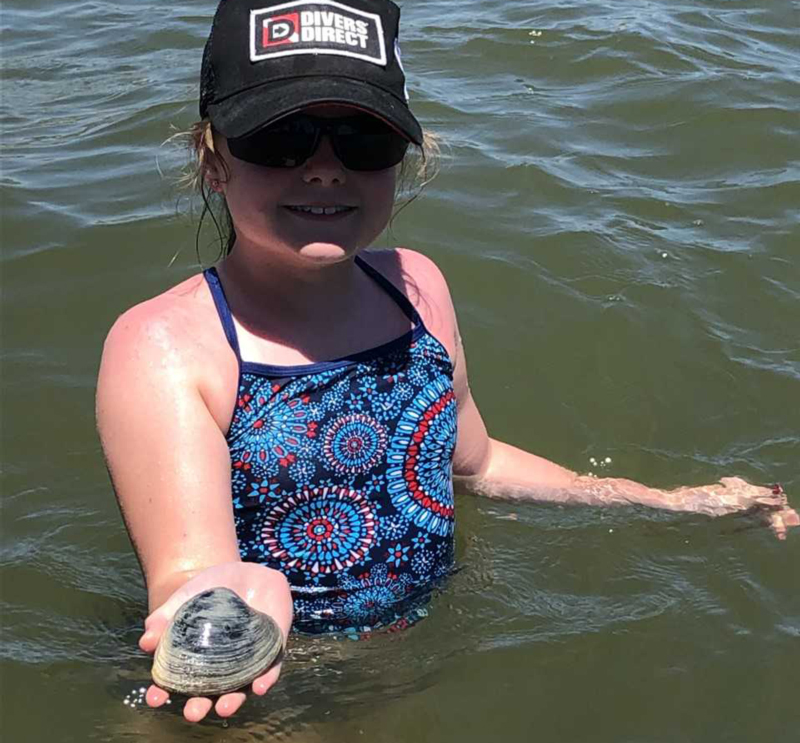If you want to truly become one with nature, clamming is the ticket. Sure, you could spend years studying Shintoism or spend hours in a trance meditating, but better yet spend a few minutes standing in knee-deep water wiggling your toes. Few activities clear the mind as thoroughly as clamming à la natural. No tools are needed, there’s no price of admission, and the biggest distraction is a crab or a baby flounder scuttling across your feet.

Wait a sec Rudow — clamming isn’t fishing! How dare you tarnish the pages of FishTalk with all this blather about bivalves?
Well, just for the record many people do consider shellfishing to be a form of “fishing,” however far off the mark of catching more, bigger fish it may be. That said, I personally don’t rank it in the same class. However, clamming is an excellent way to cap off a day of fishing at or near the beach. It takes a couple of hours at most. When you go home you’ll have a succulent bucket of rocks to toss into the steamer. And, perhaps most importantly, it does indeed make one feel as close to the natural watery world as is humanly possible. You will, after all, be standing in the bay rather than floating on top of it.
How to Find Clams
Step one in clamming is finding a good location. In most of our Mid-Atlantic coastal bays, the best clamming can be found in slightly mucky sand bottom. You’ll find a few in squishy mud, but you’ll also squish down more than you gather. Some can be retrieved from pure sandy substrates, but they’re fewer and farther between. That magical mix of muck and silica is what does the trick.
Ideal locations will be in water that’s waist deep or slightly deeper at high tide, and knee deep to ankle deep at low tide. Weedbeds generally aren’t very good, and areas with lots of sharp shells are rather painful for tool-free clamming. And, as a general rule of thumb, the farther you get from civilization the better. Not only will you find it easier to meld with the natural world, there will be less competition and hence, more clams.
Ideal locations are best prospected by boat, but there are also plenty of public areas where you can access the coastal bays by foot. When doing so it’s best to walk several hundred yards from the access point to get beyond the zone that’s regularly picked through.

You’ll often find the above-described conditions in one of two types of areas, both of which can be spotted rather easily and then probed to determine their true potential: the edges of partially submerged marsh islands, and the mouths of creeks and cuts going back into a salt marsh. When you spot a likely looking area give it a try for 10 or so minutes, and if you don’t have a handful of clams after the initial investigation, move on.
How to Dig Clams Without a Clamming Rake
So: how are we going to catch those clams while using nothing beyond our own bodies and our wits? You’ll need to use your clamdar, which is sort of like radar but shoots out from your toes. As those little piggies move through the silty substrates, they can detect the presence of a clam quite effectively. Simply wiggle them back and forth so they dig into the bottom a few inches, and when they strike a rock — that’s not a rock, it’s victory! Lean over, grab your clam, drop it in your bucket, and start wiggling again.
Advanced clamdar use involves locking your knees and rotating your hips, so your feet sweep through the silt from side to side. With every rotation push forward a few inches, and your clam detection apparatus will ping new territory. Be cautious, however, and don’t get too carried away as you load your bucket. Remember those sharp shells we mentioned earlier? They can damage your clamdar if your movements are too forceful. So use some restraint, and if you hit several shells in a row take a few steps in a different direction before powering up the phalanges again.
Yes, you will encounter clamdar interference from the likes of horseshoe crabs, conch shells, and hermit crabs. Occasionally a crab pinch or a flounder scuttle will have you leaping into the troposphere. But once you’ve found a halfway decent clamming spot and spent an hour on the hunt, you’ll have 50 to 100 of these glorious little protein nuggets in your bucket. Then all you’ll need to do is put them in a pot and apply a little steam, and you can truly become one with nature. Or, maybe nature will become a part of you.